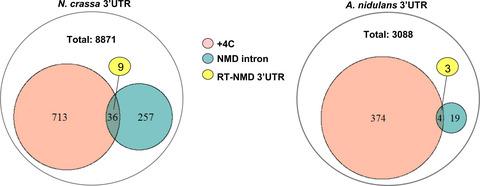当前位置:
X-MOL 学术
›
FEBS Lett.
›
论文详情
Our official English website, www.x-mol.net, welcomes your
feedback! (Note: you will need to create a separate account there.)
Expression of the translation termination factor eRF1 is autoregulated by translational readthrough and 3’UTR intron‐mediated NMD in Neurospora crassa
FEBS Letters ( IF 3.0 ) Pub Date : 2020-09-12 , DOI: 10.1002/1873-3468.13918 Anita Kurilla 1 , Anita Szőke 2 , Andor Auber 1 , Krisztina Káldi 2 , Dániel Silhavy 1, 3
FEBS Letters ( IF 3.0 ) Pub Date : 2020-09-12 , DOI: 10.1002/1873-3468.13918 Anita Kurilla 1 , Anita Szőke 2 , Andor Auber 1 , Krisztina Káldi 2 , Dániel Silhavy 1, 3
Affiliation

|
Eukaryotic release factor 1 (eRF1) is a translation termination factor that binds to the ribosome at stop codons. The expression of eRF1 is strictly controlled, since its concentration defines termination efficiency and frequency of translational readthrough. Here, we show that eRF1 expression in Neurospora crassa is controlled by an autoregulatory circuit that depends on the specific 3'UTR structure of erf1 mRNA. The stop codon context of erf1 promotes readthrough that protects the mRNA from its 3'UTR‐induced nonsense‐mediated mRNA decay (NMD). High eRF1 concentration leads to inefficient readthrough, thereby allowing NMD‐mediated erf1 degradation. We propose that eRF1 expression is controlled by similar autoregulatory circuits in many fungi and seed plants and discuss the evolution of autoregulatory systems of different translation termination factors.
中文翻译:

粗糙脉孢菌中翻译终止因子 eRF1 的表达通过翻译通读和 3'UTR 内含子介导的 NMD 自动调节
真核释放因子 1 (eRF1) 是一种翻译终止因子,在终止密码子处与核糖体结合。eRF1 的表达受到严格控制,因为它的浓度决定了翻译阅读的终止效率和频率。在这里,我们显示粗糙脉孢菌中的 eRF1 表达受自动调节电路控制,该电路取决于 erf1 mRNA 的特定 3'UTR 结构。erf1 的终止密码子上下文促进通读,保护 mRNA 免受其 3'UTR 诱导的无义介导的 mRNA 衰减 (NMD)。高 eRF1 浓度导致低效率的通读,从而导致 NMD 介导的 erf1 降解。
更新日期:2020-09-12
中文翻译:

粗糙脉孢菌中翻译终止因子 eRF1 的表达通过翻译通读和 3'UTR 内含子介导的 NMD 自动调节
真核释放因子 1 (eRF1) 是一种翻译终止因子,在终止密码子处与核糖体结合。eRF1 的表达受到严格控制,因为它的浓度决定了翻译阅读的终止效率和频率。在这里,我们显示粗糙脉孢菌中的 eRF1 表达受自动调节电路控制,该电路取决于 erf1 mRNA 的特定 3'UTR 结构。erf1 的终止密码子上下文促进通读,保护 mRNA 免受其 3'UTR 诱导的无义介导的 mRNA 衰减 (NMD)。高 eRF1 浓度导致低效率的通读,从而导致 NMD 介导的 erf1 降解。











































 京公网安备 11010802027423号
京公网安备 11010802027423号